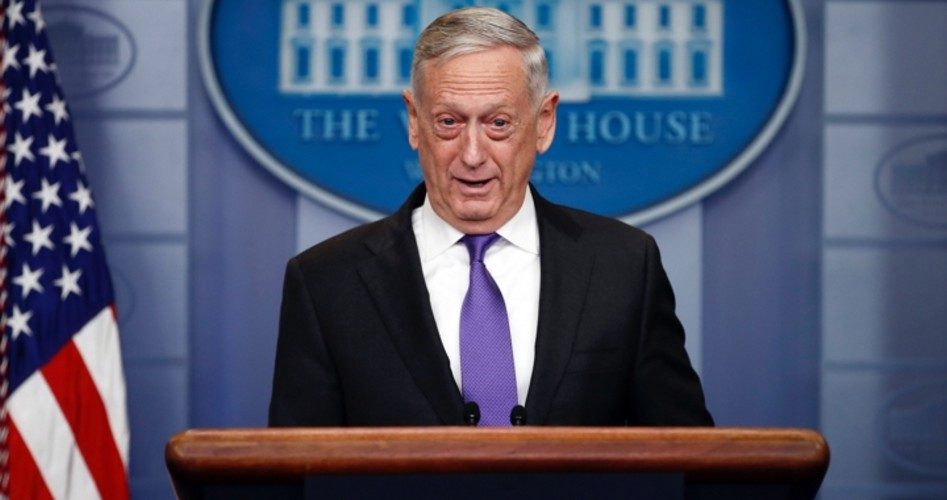
Last year, the White House announced it would reinstate the ban against transgender individuals serving in the military, but on Monday, the Pentagon confirmed that the first transgender recruit, who wished to remain anonymous, has signed up for military service. Those who support the ban against transgender individuals serving in the military contend that they will only hurt military readiness and unit cohesion, while others point to the financial burden of allowing such individuals to serve in the military.
The recruit’s enlistment may have been premature, as the White House is expected to release its official policy on transgender troops on March 23, a deadline set by President Trump. Meanwhile, Defense Secretary James Mattis’ (shown) recommendations on whether transgender troops should be allowed to serve continue to be under review at the White House.
Former Defense Secretary Ash Carter had announced in 2016 that transgender troops could serve openly in the military and that enlistment could begin in July of that year, but Mattis pushed that deadline to January of 2018 as he reviewed the Obama-era policy.
On Friday, Secretary Mattis’ recommendations were sent to the White House. Defense Department spokesman Army Colonel Rob Manning states Mattis’ recommendations are based on the findings of a department-led review late last year, which found that transgender troops could remain in the military under certain conditions. As of January 1, transgender recruits were allowed to be enlisted.
“This is a complex issue, and the secretary is taking his time to consider the information he’s been given. It’s an important issue, and again, he sees all of his decisions through the lens of lethality,” Pentagon press secretary Dana White told reporters.
In August of 2017, when President Trump directed the Pentagon to reverse President Obama’s policy of accepting transgender recruits in the military and reinstate the ban, he explained that the military “cannot be burdened with the tremendous medical costs and disruption that transgender in the military would entail.”
The Trump administration had also previously said in legal papers that the armed forces were not prepared to train thousands of personnel on the medical standards needed to process transgender applicants and might have to accept “some individuals who are not medically fit for service” if transgenders were allowed in.
According to the New York Post, four federal judges have issued rulings blocking Trump’s ban, claiming it would likely violate the right under the U.S. Constitution to equal protection under the law. But the Constitution was never intended to allow anyone, no matter how unfit they might be, to serve in the military.
Writing for the Daily Signal, Ryan T. Anderson, Ph.D., the William E. Simon senior research fellow in American principles and public policy at The Heritage Foundation, expounds on the mental-health issues associated with transgenderism and how they could impact the military:
The most helpful therapies for gender dysphoria focus not on achieving the impossible — changing bodies to conform to thoughts and feelings — but on helping people accept and even embrace the truth about their bodies and reality.
Unfortunately, 41 percent of people who identify as transgender will attempt suicide at some point in their lives, compared to 4.6 percent of the general population. And people who have had transition surgery are 19 times more likely than average to die by suicide.
People who identify as transgender suffer a host of mental health and social problems … and we need a sober and honest assessment of the human costs of getting human nature wrong.
So there were well-justified concerns that Obama was using the military to advance the latest social justice culture warrior agenda item — seeking to mainstream transgender identities and promote controversial therapies for gender dysphoria.
According to Anderson, placing individuals prone to psychological problems on a stressful battlefield is “reckless.” Anderson identifies a number of considerations that SJWs have likely not evaluated when advocating for transgender recruits.
First, he notes that the privacy of service members could become problematic as it is unclear where soldiers who identify as transgender would be housed. Anderson also contends that soldiers who have “transitioned” would not be “combat-ready” if they require regular hormone treatments and follow-up visits after surgery. Anderson notes that the military would have to decide which physical standards to set for transgender soldiers, as the standards are typically set by biological sex and not “gender identity.” A fourth consideration is whether taxpayer dollars through Tricare military health coverage should be used on controversial sex-reassignment therapies. Finally, he observes that medical judgment, religious liberties, and conscience rights will continue to impact how the military accommodates people who identify as transgender.
The military is hoping to stay ahead of at least some of these issues. According to the Washington Times, standards for transgender enlistment include certification that recruits have been deemed “clinically stable” for 18 months after their “transition,” and do not suffer from stress during military-like scenarios.
But the problem is that the approach to transgenderism has been more cultural and political than scientific and medical, making any clinic assessment more subjective and vulnerable to the influence of “political correctness” than it should be.
Photo: AP Images




